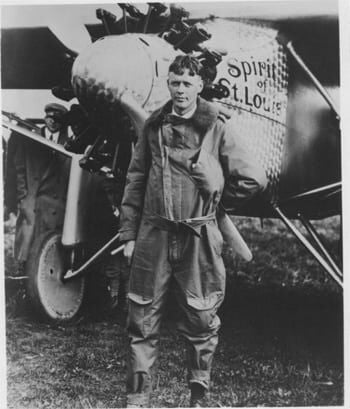On May 21, 1927, at 7:52 a.m. (New York time), Charles A. Lindbergh set off from Long Island’s Roosevelt Field. The next day, at 10:24 p.m. (Paris time), having circled the Eiffel Tower at about 4,000 feet, he landed at Le Bourget Airport, where a crowd of 150,000 greeted him. He had flown 3,614 miles non-stop in 33 hours, 30 minutes, and 30 seconds. The aviation age had begun.
Lindbergh flew with two foot pedals and a stick between his legs; his instrument panel was 10 rudimentary gauges plus a clock; there was no fuel gauge and no brakes. The plane’s wood and tubular steel frame was covered in cotton with six coats of varnish; only the nose was covered in metal. Noisy and insubstantial, the Spirit of St. Louis has been likened to a “flying gas tank.” Lindbergh described it as “5,000 pounds balanced on a blast of air.” The plane’s lack of stability meant that the sleepy Lindbergh was constantly jolted into wakefulness. Sometimes he took the plane down close to the ocean so that the spray could refresh him.
In addition to his five sandwiches and one quart of water for the flight, Lindbergh had five tins of concentrated Army rations and a gallon of water in case of emergency. According to his own account in “We,” Lindbergh also had two flashlights, one ball of string, one ball of cord, one hunting knife, four red flares sealed in rubber tubes, one match safe with matches, one larger needle, one hack saw blade, two air cushions, one air-raft with pump and repair kit, and one Armburst cup (a device for condensing moisture from breath into drinking water).
At the time of the flight, Lindbergh looked much younger than his 25 years: he was 6’2,’’ weighed 150 pounds, neither smoked nor drank (not even coffee or Coca-Cola), and had never been on a date. He flew with no sextant, only a compass. Such “dead reckoning” involved careful readings of compass headings, travel speed, time elapsed between calculations, and deviations from the prescribed route caused by drifting; his calculations were made on his lap while flying an unstable plane.
After the flight, the New York Times devoted its first four pages to the event. Over the first four days, U.S. newspapers ran an estimated 250,000 stories on the flight, totaling 36 million words; the aviator received more than 3.5 million letters, mostly from women, as well as 15,000 parcels of gifts; and songwriters produced at least 250 popular songs, including “Lucky Lindy.” The U.S. Post Office issued a 10-cent postage stamp featuring Lindbergh’s plane and route.
According to Donald A. Hall, a chief engineer at Ryan Airlines, the company that built the plane, the Spirit of St. Louis was 27 feet and 8 inches in length, 9 feet and 10 inches in height, and had a 46 feet wingspan with 7 feet wing chords. It had a 223 horsepower engine and an 8 feet 9 inch steel propeller. Its 850-gallon fuel capacity was distributed in tanks throughout the plane. When empty, the plane weighed 2,150 pounds, 5,135 when loaded for the flight. Its cost was $10,580.
The Wright J-5 Whirlwind engine was the latest technology: air-cooled making it simpler, lighter, and more reliable than conventional water-cooled engines; it was the first machine in the world to incorporate sodium-cooled valves, which eliminated the serious problem of burned exhaust valves; it had self-lubricating rocker arms, which could putter along contentedly for hours without attention.


